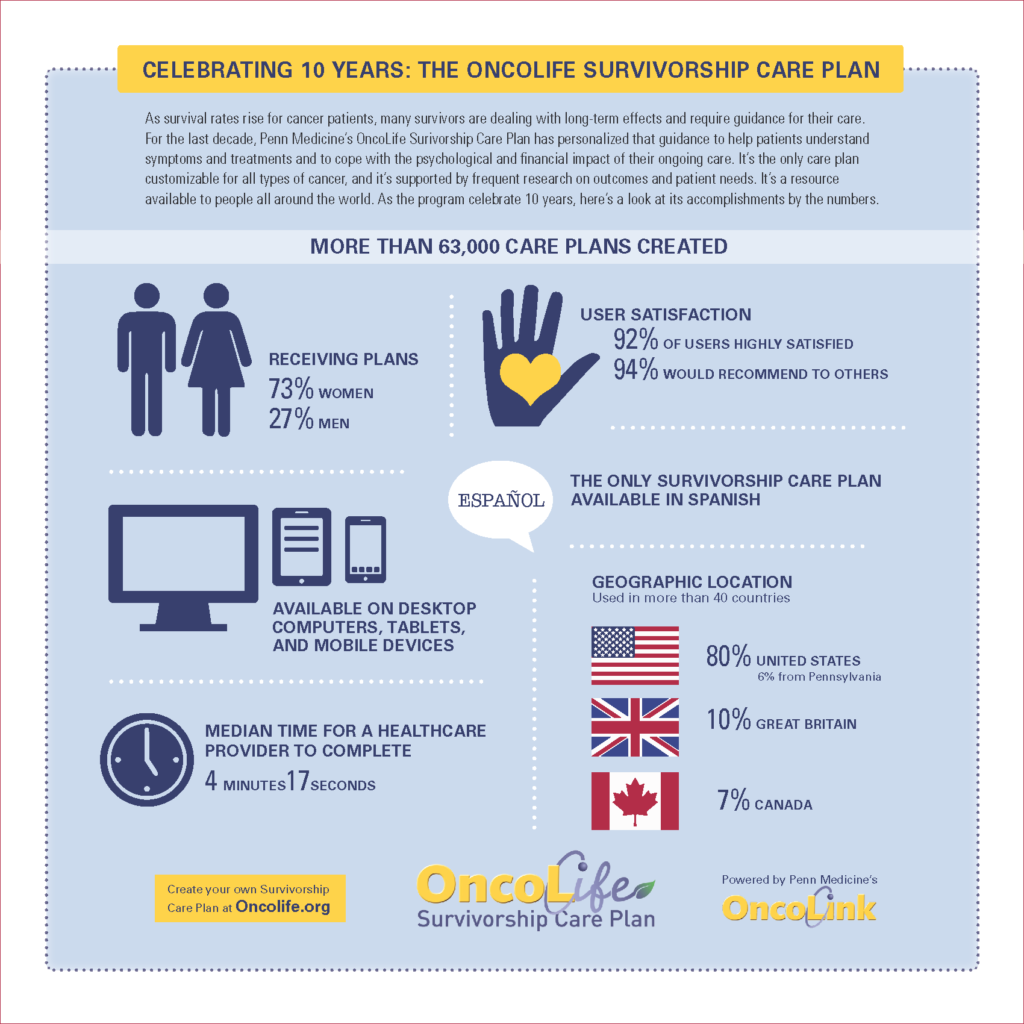When OncoLink launched in 1994, it was the first cancer information website on the internet. Twenty-three years later, it remains one of the largest. Housed at Penn Medicine, with a focus on patient and provider education, OncoLink has continued to evolve as cancer treatment has changed over the years. In April of 2007, the group launched the OncoLife Survivorship Care Plan, a user-generated service that creates care plans for patients who have survived cancer. As that plan marks 10 years, OncoLink’s Managing Editor, Carolyn Vachani, looks back on the program’s origins.
In 1996, The Institute of Medicine published a report called “From Cancer Patient to Cancer Survivor: Lost in Transition.” This report shined a light on the issues people face after cancer treatment and the lack of support to help them cope with these issues. It was a comprehensive review of the after-effects of cancer treatment; in other words, health problems caused by the treatments themselves. These are often referred to as long-term (lasting years after treatment) or late (occurring months to years after treatment) effects. The report also highlighted the psychological and practical concerns after a diagnosis. It suggested all survivors should receive a treatment summary detailing the treatments they received, and a survivorship care plan that incorporates physical, psychological and practical after-effects of treatment and how to prevent and/or manage them.
Soon after this report, you would have been hard pressed to find a conference for oncology professionals that didn’t have one – if not many – sessions on the topic of survivorship. Like it or not, a new buzzword had been created.
I sat in many of those conference sessions hearing about all the pieces of information a survivor should receive and how difficult it was to provide this information. I started to feel that perfection was becoming the enemy of good. There was a lot of information we could provide survivors. Was it perfect, research-based information to cover everything the IOM wished for? Not completely, but from a survivor’s perspective, some helpful information was certainly better than no information at all.
Over at OncoLink, we were receiving emails from survivors wondering if health issues they had could be related to their cancer treatments. The answer was usually yes, but short of visiting a medical library and combing through journals, a patient wouldn’t come across this information easily, and often their healthcare providers were unaware of the connection. This got our little team brainstorming. At the heart of our mission is education, and just like we teach patients about managing nausea or hair loss, we felt compelled to teach survivors about life after cancer. But every treatment had different long term and late effects. We needed a program to compile information specific to whatever treatment that user had received. It had to be easy to use and accessible to patients, using treatment information a patient would know, then presenting what they needed to know in our usual conversational style. We got to work.
After a year dedicated to researching, writing, and tech building, we had created a program to help survivors learn about long term and late effects in a survivorship care plan format. The first version of the OncoLife Survivorship Care Plan was launched on April 23, 2007. Our goal was to educate survivors, help them learn about prevention and monitoring for late effects, and most importantly, help them start a conversation with their healthcare providers about late effects. We had no idea where this little-engine-that-could would go, but we were ready for the ride.
Flash forward ten years, and this little engine has grown substantially. OncoLife has been used to create more than 63,000 care plans to date. Healthcare providers all over the country (and world!) use this program to create survivorship care plans, providing survivors with information to guide them through life after cancer. Over the last decade, we have expanded on the original physical effects content by adding psychological and practical support, tobacco cessation information, cancer follow up and screening information, and tips for healthy living. The tools use adaptive filtering to personalize the user’s experience based on their cancer type. OncoLife covers all cancer types and is the only survivorship care plan available in Spanish.
The field of oncology survivorship is still in its infancy – there is much to learn. As the number of cancer survivors grows to more than 17 million, we are likely to see more health concerns brought on by treatment. In addition, the past decade has seen the development of many new cancer treatments, and only time will tell how these will affect survivors long-term. Our team is committed to keeping the OncoLife care plan up to date, adding new research and guidelines as they become available. We are working towards integrating the plan with electronic medical records, making the creation and distribution of care plans easier for practitioners. We are testing a new version of the plan, designed for adults who had cancer as a child, providing health information to this group who received cancer treatments during times of critical development of their bodies and minds.
As I look back on all this little engine has achieved, I am so proud of this team. The goal of getting information to survivors kept this engine going when many said it couldn’t be done. Sadly, 21 years after the IOM report, most survivors still do not receive care plans. This little engine is going to keep on chugging until they do.
Are you a survivor? Create your survivorship care plan at www.oncolife.org


Before survivorship, you need to coordinate care. I was given my diagnosis over the phone and not by a physician. Another caller later told me what “grade” my tumor was, but again,without any explanation. I was alone in my office at work sat staring at th phone. Come on, UPenn, you need to do better and. Provide support for pts from the start, not just when they finish treatment!,,,
I’m a cancer survivor too.I can remember how my family was continuing the cancer treatments even though I repeatedly asked them to stop spending on me.The fight they carried won at last.I advice even after surviving from cancer please do not stop the care given earlier.